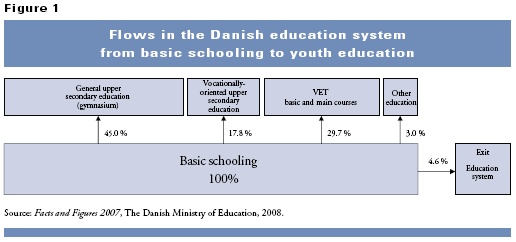
|

Introduction to the Danish VET systemThe Danish VET system is part of the overall youth education system and aims at developing the general, personal and vocational skills of young people. The overall objectives of VET are laid down in the Act on Vocational Education and Training3. According to this, the aim of the programmes is not only to provide the trainees with vocational qualifications, which are formally recognised and in demand by the labour market, but also to provide them with general and personal qualifications that open up the trainees’ possibilities for lifelong learning and for active citizenship. The system is based on three main principles:
A definition: Facts and figures about VET in Denmark Approximately one third of a youth cohort enrols in a VET programme after basic schooling (2007). There is a decrease in the number of young people who enter a VET programme as the trend is currently for young people to opt for the more academically-oriented upper secondary education programmes. The most popular programmes are the commercial, building and construction, technology and communication, and the social and health care programmes. The drop-out rate is high. Only around 70% complete the basic course and 80% complete the main course. Many of the trainees who drop out continue in other VET programmes or in the general upper secondary education programmes. Nonetheless, 40% of all dropouts are estimated not to continue any education or training programme within the next ten years. The dropout rate is higher among men than women and higher among immigrants than among those with Danish origin. In general, drop-out rates are a major problem in the Danish VET programmes, and reducing the number of trainees dropping out, especially in technical training, is an important political priority. Approximately 80% of those completing a VET programme enter the labour market and are employed in a company one year after completion. The number of male trainees in VET is, on average, marginally higher than the number of females trainees: with 55% male trainees and 45% female trainees. However, gender distribution is uneven among the various programmes, e.g. within the social and health care programmes, female trainees constitute 93%, whilst within traditionally male sectors, such as mechanical engineering, transport and logistics, they constitute only 4%. The average age of trainees on the basic courses was 21 in 2005. For the main courses, the average age was 26. In 2005, one out of ten trainees were immigrants or from ethnic minorities. Danish VET is characterized by four objectives: to be an involving, flexible, inclusive and developing system. In the following chapters 2-5, these four objectives are further elaborated.
Source: 
Footnotes3) The Act on Vocational Education and Training LBK no. 561 of 06/06/2007.
|
||
|
To the top of the page |